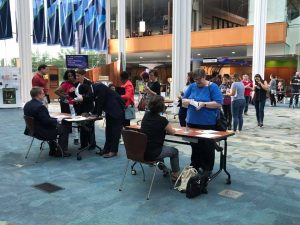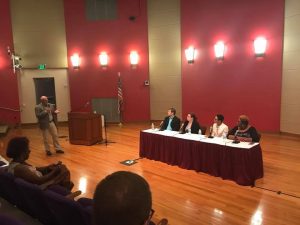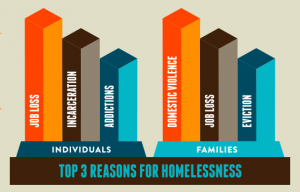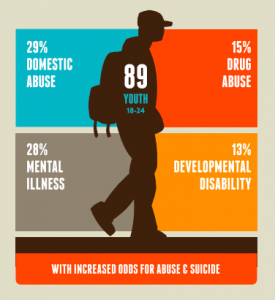DVN Co-hosts Poverty Simulation with CHIP and Institute for Working Families
By: Mary-Margaret Sweeney, Director of Community Engagement, Domestic Violence Network
It is an adage so common, we are no longer sure who to attribute it to: put yourself in someone else’s shoes. We say this to help children learn empathy. We say it to help adults remember their lessons on empathy. What is it like to be someone else? Can we understand someone better if we try to imagine what it is like to live their life? Domestic Violence Network (DVN), Coalition for Homelessness Intervention and Prevention (CHIP), and the Institute for Working Families facilitated this thought experiment in real time recently at Central Library. The event was a part of DVN’s Community Wide Plan, Intersections, that explored the intersection of domestic violence and economics for the first half of 2017.
CHIP has created a simulation, titled “A Day in the Life,” so participants can understand what it is like to exist in poverty. Each participant receives their life story, and they must navigate the simulation to try and access housing, food, transportation, clothing, the court system, health care, education etc. Some characters had a criminal record that they found inhibited their ability to access housing or employment. Some were able to find resources for themselves, but struggled to take care of their kids. At any point, one of the simulation facilitators could walk up to a participant and throw a situation at them that changed their course. Other facilitators were set up at stations, playing roles such as a health department worker, a paralegal at the legal aid office, or a law enforcement officer at the jail. These actors had the ability to grant or deny services and make access easy or more difficult. DVN’s director of programs, Lindsay Stawick, struggled in her role as the paralegal of a legal aid clinic. “I felt so badly turning people down who needed help!” she said. “People I knew from my work at DVN would come and ask me to help their character expunge a criminal record so they could stay at the homeless shelter, and even though I was playing a role, I kept apologizing. I wanted to help everyone.”
Facilitators were impacted, as were the participants navigating their characters. A participant who asked that their name not be used said “I honestly have blamed people for being in the exact situations I am trying to figure out now. And I feel so frustrated just pretending. I feel really badly about how I used to think. This was definitely eye-opening.”
At the conclusion of the simulation, many participants had not been able to meet all their basic needs. To process the exercise, the group headed into Clowes Auditorium for a panel discussion. DVN, CHIP, and the Institute were so excited to host our expert panel: Alan Witchey, executive director of CHIP; Jessica Fraser, director of Institute for Working Families; Deagria Level, Americorps service member at The Julian Center; and Talia Pinner, housing advocate at Coburn Place. We had a very special moderator as well–John Krull, host of WFYI’s No Limits. Mr. Krull posed questions to the panel about the policy work they think could benefit people living in poverty, and asked Ms. Level and Ms. Pinner to help the audience understand the connection between domestic violence, poverty, and homelessness. According to CHIP, domestic violence is the number one reason families experience homelessness. 29% of homeless youth reported experiencing domestic violence.
Toward the end of the panel discussion, Mr. Krull made an observation regarding the setup of the simulation that succinctly summed up the experience of poverty. “I don’t know if this was intentional or not,” he said. “But the simulation was set up so the participants were surrounded by the stations. It’s set up like a cage. Once you enter, it’s so hard to exit.”




